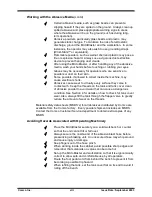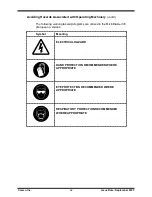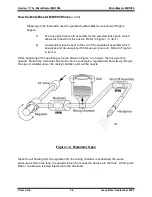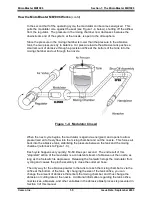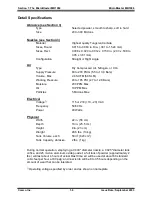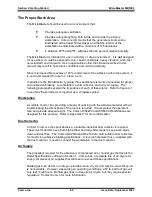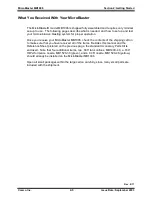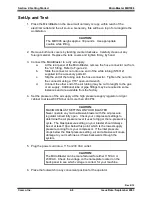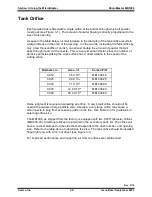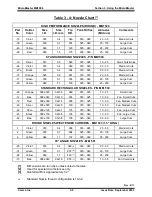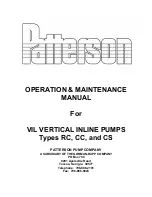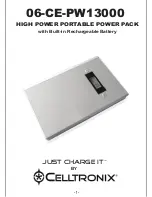
Section 2: Getting Started
MicroBlaster MB1006
Comco Inc.
2-4
Issue Date: September 2003
Figure 2-2: MicroBlaster Reference Sheet
Figure 2-2 is an illustration of the Reference Sheet that comes with your MicroBlaster. It
contains important information you can use to get the most out of your investment. Keep
it nearby and refer to it often. However, it cannot substitute for the comprehensive data
found in this manual. Prior to setting up and operating your MicroBlaster, the operator
and the department supervisor should carefully review this entire manual.
QUICK START INSTRUCTIONS
You may use this tip sheet to quickly get your MicroBlaster set up and ready to operate, and as a ready reference for common questions regarding the
operation of the MicroBlaster. Keep it nearby and refer to it often. For complete details on the MicroBlaster, Comco strongly urges you to read the manual
completely.
The money invested in this equipment justifies this time.
SAFETY PRECAUTIONS
1
The MicroBlaster operates using high voltage electrical power and high-pressure air. Proper set-up, operation, and maintenance are
essential for safe use. Read the Safety Precautions in the introduction of the manual before using your MicroBlaster.
2
You must use proper dust collection and a WorkStation in conjunction with the equipment.
3
Never point the nozzle at exposed skin, eyes, or face.
4
Always be sure that the nozzle is held firmly before activating the foot pedal.
5
Add abrasive to the tank through the “Quick-fill” valve using the funnel provided in the accessory kit. Wipe the flapper and O-ring with
a soft dry towel after abrasive powder is added with the funnel to get an airtight seal. Don’t overfill the tank. 1 1/4” from the top is
maximum. Make sure the tank cover is tightened snugly.
To change abrasives, see instructions in Section 3.
MICROBLASTER SETUP TIPS
1
Verify that the hose from the dust collector is connected to the 4” collar on the back panel of the WorkStation. For optimum dust collection, the
hose should be as short as possible.
2
Position the MicroBlaster on top or along side of the WorkStation.
3
Verify the MicroBlaster is connected to a dry air supply of 80 - 200 PSIG. Bottled CO
2
or nitrogen is recommended if dry air from a
compressor is not available. See page 2-6 of the manual for instructions.
Note: If the pinches on the rear panel do not close when the machine is turned on, the air supply pressure is probably too low.
4
Pass the handpieces through the small ports on the side of the WorkStation.
The “Tank Vent” hoses should be pushed 2-3” through a grommet
on the backside of the WorkStation.
5
Add abrasive to the tanks through the “Quick-fill” valve using the funnel provided in the accessory lot. Wipe the flapper and O-ring with a soft dry
towe
l after abrasive powder is added with the funnel to get an airtight seal. Don’t overfill the tanks. 1 1/4” from top is the maximum. Make sure
the tank covers are tightened snugly. To change abrasives, see instructions in Section 3 of the manual.
6
Turn on the facility dust collector.
7
Turn the MicroBlaster Power ON. Adjust pressure regulator to desired blasting pressure (see Section 3 of the manual for details).
8
Place the item(s) to be blasted into the WorkStation. Hold the handpiece firmly and direct the nozzle toward the area to be blasted. Never point
the nozzle toward the glass window. Begin blasting by depressing the footswitch.
9
The speed and type of cut will vary with the distance and angle of the nozzle. See section 3 for concise information.
10
To shut down the system, turn the Power switch to OFF. Verify that the pressure gage reads zero.
NOTE: There is no need to depressurize after each use. Frequent shutdown causes excessive wear and will waste abrasive. Th e MicroBlaster
is designed to remain pressurized for an entire work shift.
Summary of Contents for MicroBlaster MB1006
Page 10: ......



